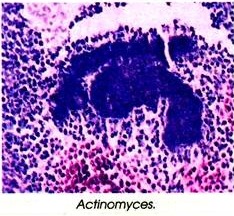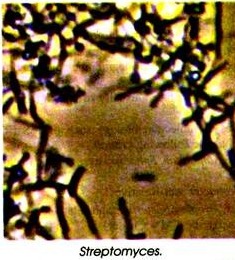ADVERTISEMENTS:
In this article we will discuss about the features of actinomycetes with its suitable diagram.
Actinomycetes are called actinobacteria or high G + C rich Gram-positive filamentous bacteria due to their mycelium like (slender and branched) structures. These filaments are long and it may fragment into much smaller units and less broad than that of the fungal mycelium usually 0.5 to 1.0 µm in diameter but sometimes reaches to 2.0 µm in few cases.
A chain of sexual spores called conidia are produced on their hyphae, and few of the actinomycete (genera) found in soil bear the sporangium containing spores. The colonies are powdery mass over the surface of culture media, often these are pigmented when the aerial spores are produced.
They are Gram-positive rod-shaped to filamentous, aerobic and generally non-motile in the vegetative phase. Due to their rod-shaped arrangement, they are called filamentous bacteria. Most of the genera have high mol (%) G+C. They are morphologically quite different with each other.
Actinomyces is anaerobic to facultatively aerobic, filamentous micro-colony, whereas Streptomyces has intact and abundant aerial mycelium with long chain spores. Nocardia a common soil organism is an obligate aerobe. Nitrogen-fixing actinomycetes, Frankia produces true mycelium, and they are microaerophilic and live symbiotically with non-leguminous plants. The characteristics of some important genera are given below.
Micrococcus, is a non-motile, Gram-positive cocci, aerobic with a high DNA base composition (66 to 72 mol % G + C). It is generally found in soil and produce correlated pigments yellow to red in colour. This helps in protection against UV light. Arthrobacter, is also a soil-inhabitant. They are coccoid but when growing actively, they form irregular rods. They are Gram-positive but some strains are Gram-negative. Some are motile in nature.
Frankia, is a plant symbiont that produces root-nodules fixes nitrogen in non-leguminous plants such as Alnus (alder), Ceanothus (wild lilae) and Casuarina (Australian pine or She-wood). It is difficult to cultivate on artificial culture medium. The aerial mycelium develops multicellular sporangium.
ADVERTISEMENTS:
Actinomyces is a typical mycelial actinobacteria. They are anaerobic or facultative anaerobic microorganism. They do not produce an aerial mycelium. A. bovis grows in oral cavities and can cause serious infection such as lumpy jaw.
Bifidobacterium, is a mycelial form but recently, its phylogeny places it as a similarity to Actinomyces. It is anaerobic, irregular rod-shaped bacteria, found in the intestinal tracts of animal e.g. B. bifidus. It also grows in human breast milk which contains amino sugar not found in cow’s milk.
Streptomyces, is mycelial forming actinobacteria that lives in soil, produces aerial as well as substrate mycelium. The aerial hyphae differentiate to form asexual conidiospores in chains. They are blue, gray, green, red, violet or yellow colour.
They impart “earthy’ odor to soil after rain which is due to the presence of geosmines (volatile organic compound), some important antibiotics namely, streptomycin, chloramphenicol and tetracycline are produced from this genus.
Helicobacteria, is recently discovered actinobacteria. This is the only phototrophic Gram- negative bacteria, required organic carbon sources. They have a unique type of bacteriochlorophyll called bacteriochlorophyll g e.g. Helicobacillus and Helicobacter. They are anaerobes carrying out anoxygenic photosynthesis.


